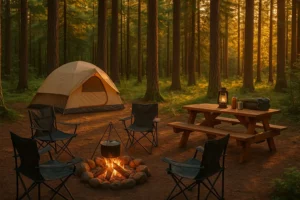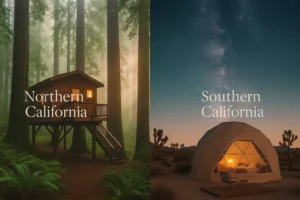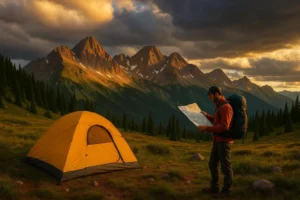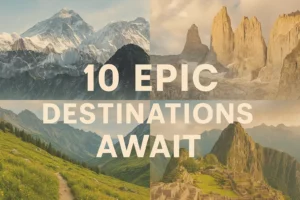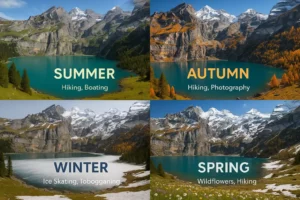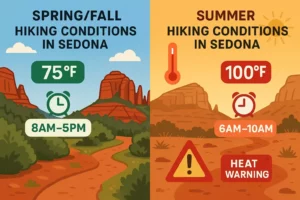Your Guide to the Best Hiking Trails in Banff National Park
Picture this: towering snow-capped peaks reflecting in crystal-clear alpine lakes, ancient glaciers carving through emerald valleys, and wildlife roaming freely through pristine wilderness. Welcome to Banff National Park, Canada’s crown jewel and one of the world’s most spectacular hiking destinations. 🏔️
Nestled in the heart of the Canadian Rockies, Banff National Park offers over 1,600 kilometers of maintained trails that cater to every skill level and adventure appetite. Whether you’re seeking a leisurely family stroll around a turquoise lake or an adrenaline-pumping scramble to a mountain summit, Banff delivers experiences that will leave you breathless—literally and figuratively.
Key Takeaways
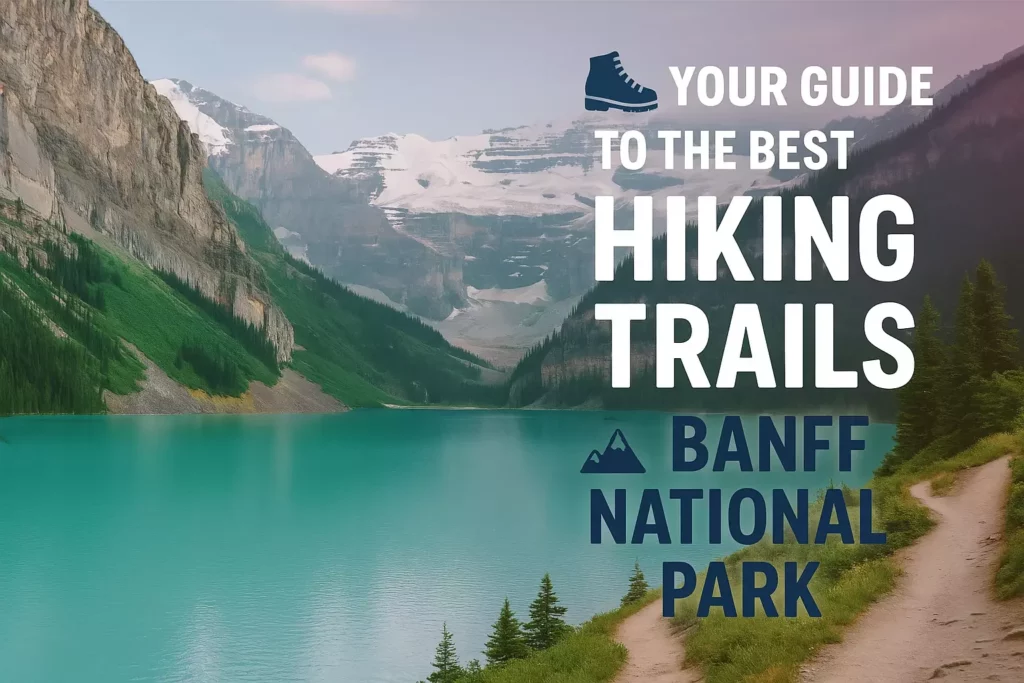
- Trail diversity: Banff offers over 80 hiking trails ranging from easy lakeside walks to challenging multi-day backcountry adventures
- Best hiking season: July through September provides optimal weather conditions and trail accessibility
- Essential preparation: Proper gear, permits, and safety knowledge are crucial for a successful Banff hiking experience
- Wildlife awareness: Bears, elk, and mountain goats are common—understanding wildlife safety is mandatory
- Booking requirements: Popular trails and backcountry camping require advance reservations, especially during peak season
Understanding Banff’s Trail System
Banff National Park’s extensive trail network is meticulously organized into difficulty levels that help hikers choose appropriate adventures. The park uses a standardized rating system:
Easy Trails (1-3 hours): Well-maintained paths with minimal elevation gain, perfect for families and beginners
Moderate Trails (3-6 hours): Some steep sections and elevation changes, requiring basic fitness
Difficult Trails (6+ hours): Steep ascents, technical terrain, and significant elevation gain demanding excellent fitness
Trail Classifications and What They Mean
| Difficulty | Distance Range | Elevation Gain | Time Required | Skill Level |
|---|---|---|---|---|
| Easy | 1-5 km | 0-200m | 1-3 hours | Beginner |
| Moderate | 5-15 km | 200-800m | 3-6 hours | Intermediate |
| Difficult | 15+ km | 800m+ | 6+ hours | Advanced |
The park’s trail system connects through various regions, each offering unique landscapes and experiences. From the bustling Bow Valley to remote backcountry wilderness, understanding these zones helps plan your hiking adventure effectively.
Top Easy Hiking Trails for Beginners
Bow River Trail
Distance: 9 km (one way) | Elevation Gain: Minimal | Time: 2-3 hours
The Bow River Trail serves as Banff’s gateway hiking experience, offering stunning mountain views without challenging terrain. This paved pathway follows the Bow River from Banff townsite to the Bow Falls, providing excellent opportunities for wildlife spotting and photography.
Highlights:
- Accessible year-round
- Perfect for family camping groups
- Multiple access points and parking areas
- Excellent bird watching opportunities
Lake Minnewanka Loop
Distance: 2.4 km | Elevation Gain: 50m | Time: 45 minutes
This easy loop around Banff’s largest lake offers breathtaking mountain reflections and historical insights. The trail features interpretive signs explaining the area’s Indigenous history and the lake’s transformation into a reservoir.
Johnston Canyon Lower Falls
Distance: 2.2 km (round trip) | Elevation Gain: 60m | Time: 1 hour
One of Banff’s most popular easy hikes, Johnston Canyon Lower Falls features well-maintained catwalks suspended over the rushing canyon. The trail leads to a spectacular 30-meter waterfall viewpoint.
Pro Tip: Visit early morning or late afternoon to avoid crowds and capture the best lighting for photography.
Moderate Hiking Adventures
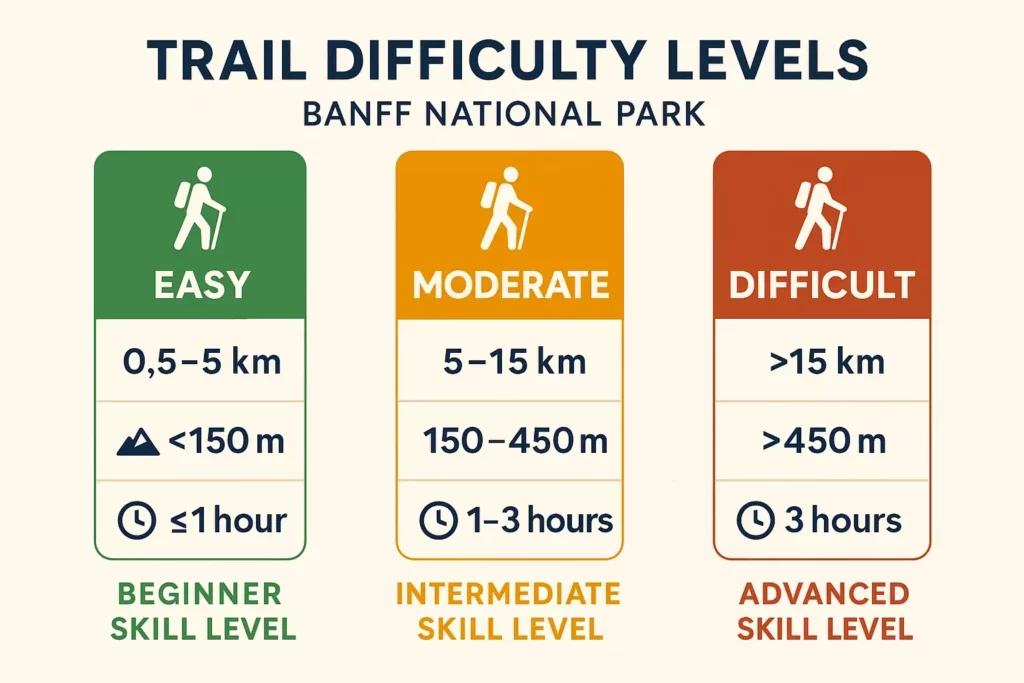
Lake Agnes Tea House
Distance: 7 km (round trip) | Elevation Gain: 400m | Time: 3-4 hours
This classic Banff hike combines moderate challenge with historical charm. The trail begins at Lake Louise and climbs through subalpine forest to a century-old tea house serving fresh-baked goods and hot beverages.
What to Expect:
- Steep switchbacks through dense forest
- Mirror Lake viewpoint halfway up
- Operating tea house (seasonal)
- Stunning views of Lake Louise below
Before attempting this hike, ensure you have proper hiking gear and understand basic trail safety principles.
Tunnel Mountain
Distance: 4.5 km (round trip) | Elevation Gain: 300m | Time: 2-3 hours
Despite its name, Tunnel Mountain features no tunnel but offers panoramic views of Banff townsite and surrounding peaks. This moderate climb provides excellent training for more challenging hikes.
Trail Features:
- Well-marked switchbacks
- 360-degree summit views
- Year-round accessibility
- Perfect sunset viewing location
Plain of Six Glaciers
Distance: 14 km (round trip) | Elevation Gain: 370m | Time: 4-6 hours
Starting from the iconic Chateau Lake Louise, this moderate hike leads to a historic tea house with spectacular glacier views. The trail showcases the dramatic landscape carved by ancient ice flows.
Challenging Trails for Experienced Hikers
Mount Assiniboine Provincial Park
Distance: 27 km (one way) | Elevation Gain: 570m | Time: 2-3 days
Known as the “Matterhorn of the Rockies,” Mount Assiniboine requires serious preparation and backcountry camping gear. This challenging trek rewards hikers with alpine meadows, pristine lakes, and the iconic pyramid peak.
Essential Requirements:
- Backcountry camping permit
- Bear spray and food storage
- Navigation skills and map/compass
- Emergency communication device
Skyline Trail (Maligne Lake)
Distance: 44 km | Elevation Gain: 1,100m | Time: 2-3 days
This challenging backcountry route traverses high alpine terrain with spectacular ridgeline walking and panoramic mountain views. The trail demands excellent fitness and wilderness experience.
Valley of the Five Lakes
Distance: 9.2 km (round trip) | Elevation Gain: 100m | Time: 3-4 hours
While not extremely difficult, this trail offers moderate challenge with extraordinary rewards. Five distinct lakes, each displaying unique colors due to varying mineral content and depth, create a photographer’s paradise.
Essential Gear and Safety Considerations
Must-Have Hiking Equipment
Basic Day Hiking Gear:
- Sturdy hiking boots with ankle support
- Weather-appropriate layered clothing
- Rain jacket and warm layers
- Navigation tools (map, compass, GPS)
- First aid kit with wilderness-specific supplies
- Emergency whistle and headlamp
- Sun protection (hat, sunglasses, sunscreen)
Extended Hiking Essentials:
- Proper sleeping bag rated for mountain conditions
- Lightweight tent suitable for alpine environments
- Water purification system
- Stove and cooking equipment
- Bear spray and bear-proof food storage
Weather Considerations
Banff’s mountain weather changes rapidly and dramatically. Even summer days can bring snow, rain, or extreme temperature swings. Always check current conditions and be prepared for weather worse than forecasted.
Seasonal Weather Patterns:
- Summer (July-August): Warm days (20°C), cool nights (5°C), afternoon thunderstorms
- Fall (September-October): Cool temperatures, early snow possible, shorter daylight
- Winter (November-March): Snow-covered trails, extreme cold, specialized equipment required
- Spring (April-June): Muddy trails, unpredictable conditions, avalanche risk
Proper cool weather clothing becomes essential as elevation increases and weather conditions deteriorate.
Wildlife Safety in Banff
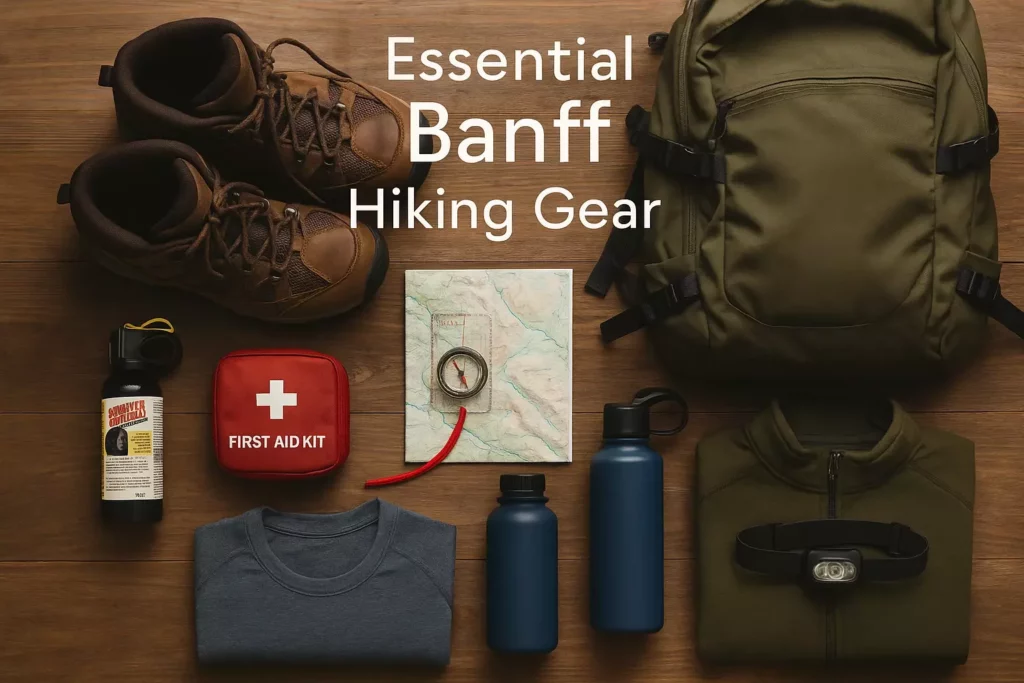
Banff National Park hosts an impressive array of wildlife, including grizzly bears, black bears, mountain goats, elk, and cougars. Understanding wildlife behavior and safety protocols isn’t just recommended—it’s essential for survival.
Bear Safety Essentials
Prevention Strategies:
- Travel in groups and make noise on blind corners
- Carry bear spray and know how to use it effectively
- Store food properly in bear-proof containers
- Never approach or feed wildlife
Bear Encounter Protocol:
- If you see a bear: Back away slowly, avoid direct eye contact, speak calmly
- If a bear approaches: Stand your ground, make yourself appear larger, prepare bear spray
- If attacked: Fight back against black bears, play dead for grizzly attacks (unless predatory)
Other Wildlife Considerations
Elk and Mountain Goats: Maintain 30-meter distance, especially during rutting season (fall)
Cougars: Rare but dangerous—maintain eye contact, appear large, back away slowly
Smaller Wildlife: Marmots, pikas, and ground squirrels may carry diseases—observe from distance
🏔️ Find Your Perfect Banff Trail
Planning Your Banff Hiking Adventure
Best Time to Visit
Peak Season (July-September): Optimal weather conditions, all trails accessible, but expect crowds and higher accommodation costs. Book reservations well in advance.
Shoulder Seasons (May-June, October): Fewer crowds, variable weather, some high-elevation trails may be snow-covered. Excellent for photography with changing seasons.
Winter (November-April): Limited trail access, specialized winter gear required, but offers unique snowshoeing and cross-country skiing opportunities.
Permits and Reservations
Day Hiking: No permits required for most day hikes, but parking can be extremely limited at popular trailheads. Arrive early or use Parks Canada shuttle services.
Backcountry Camping: Mandatory reservations and permits required. Bookings open in January for the following season and popular sites fill within hours.
Fishing: Separate fishing licenses required for any angling activities along hiking routes.
Transportation and Access
Getting There: Calgary International Airport serves as the primary gateway, located 90 minutes from Banff townsite. Rental cars provide maximum flexibility for accessing trailheads.
Parking Challenges: Popular trailheads fill by 8 AM during peak season. Consider:
- Parks Canada shuttle services
- Early morning starts
- Midweek hiking
- Alternative trailhead access points
Public Transportation: Limited but improving shuttle services connect major trailheads during summer months.
Family-Friendly Hiking Options
Banff offers exceptional opportunities for family camping adventures with trails suitable for children and multi-generational groups.
Kid-Friendly Trail Features
Interpretive Trails: Educational signage keeps children engaged while learning about local ecology and history.
Short Distances: Trails under 3 kilometers prevent fatigue and maintain enthusiasm.
Interesting Destinations: Waterfalls, lakes, and wildlife viewing opportunities capture young imaginations.
Recommended Family Trails
- Fenland Trail (2 km loop): Wheelchair accessible boardwalk through wetlands
- Bow Falls (1 km): Easy walk to impressive waterfall near Banff townsite
- Lake Louise Shoreline (2 km): Flat lakeside path with stunning mountain reflections
- Cascade Ponds (1 km): Short loop with picnic areas and mountain views
When planning family hikes, pack appropriate gear for children and prepare engaging activities to maintain interest throughout the journey.
Photography and Nature Observation
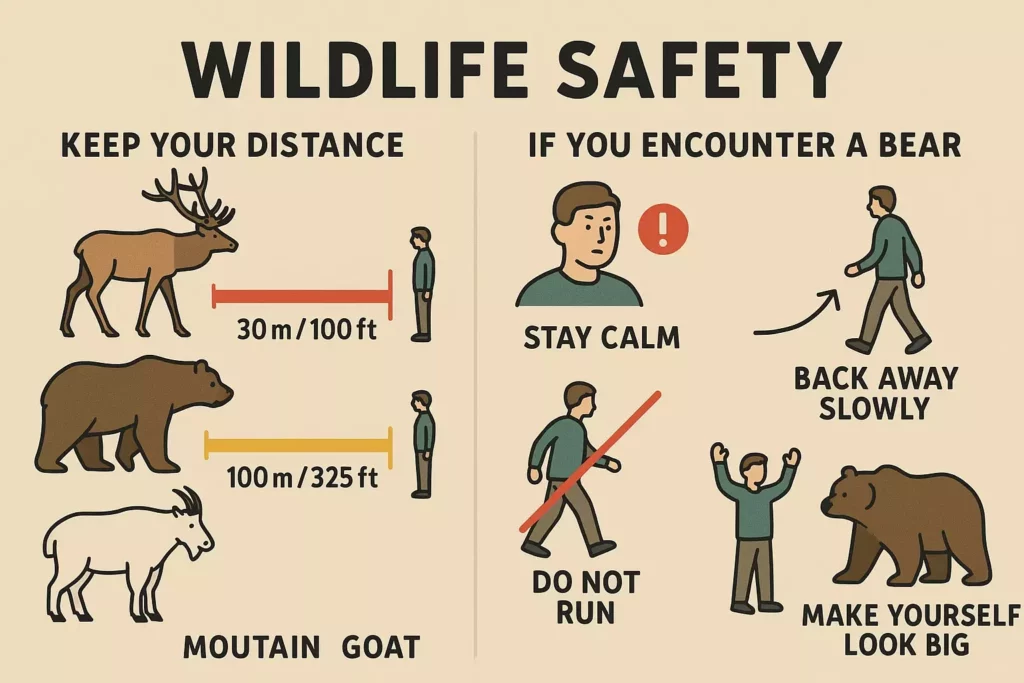
Banff’s dramatic landscapes provide endless photography opportunities, from intimate wildflower details to sweeping mountain panoramas.
Best Photography Locations
Golden Hour Spots:
- Lake Louise at sunrise
- Moraine Lake (Valley of the Ten Peaks)
- Tunnel Mountain summit at sunset
- Bow River reflections
Wildlife Photography:
- Bow Valley Parkway for elk and bears
- Lake Minnewanka for bighorn sheep
- Johnston Canyon for birds and small mammals
Photography Ethics and Guidelines
- Maintain safe distances from wildlife (minimum 100 meters for bears, 30 meters for elk)
- Stay on designated trails to protect fragile alpine vegetation
- Respect other hikers’ experiences—avoid blocking viewpoints
- Follow Leave No Trace principles
Seasonal Hiking Considerations
Summer Hiking (July-September)
Advantages:
- All trails accessible
- Warmest weather conditions
- Wildflower blooms in alpine meadows
- Longest daylight hours
Challenges:
- Peak crowds and traffic
- Afternoon thunderstorms
- Biting insects in lower elevations
- Higher accommodation costs
Fall Hiking (September-October)
Advantages:
- Spectacular autumn colors
- Reduced crowds
- Stable weather patterns
- Excellent photography conditions
Challenges:
- Shorter daylight hours
- Possible early snowfall
- Some facilities close for season
- Rapidly changing weather
Spring Hiking (April-June)
Advantages:
- Waterfalls at peak flow
- Migrating wildlife activity
- Moderate temperatures
- Fewer tourists
Challenges:
- Muddy and unstable trail conditions
- Avalanche risk at higher elevations
- Unpredictable weather
- Limited facility operations
Emergency Preparedness and Safety
Communication and Navigation
Cell Service: Extremely limited or non-existent on most trails. Don’t rely on smartphones for emergency communication.
Emergency Devices: Consider satellite communicators or personal locator beacons for remote hiking.
Navigation Tools: Always carry paper maps, compass, and GPS device. Know how to use them before heading out.
Emergency Procedures
If Lost: Stop, stay calm, and use the STOP protocol (Sit, Think, Observe, Plan). Stay in one location to aid rescue efforts.
Injury Protocol: Assess severity, provide first aid, signal for help, and prepare for potential overnight stay.
Weather Emergencies: Seek immediate shelter, avoid exposed ridges during lightning, and be prepared for rapid temperature drops.
Having a comprehensive first aid kit designed for wilderness conditions can be life-saving in emergency situations.
Advanced Hiking Techniques
Alpine Start Strategy
Many challenging Banff hikes benefit from alpine starts—beginning before dawn to avoid afternoon weather and crowds.
Benefits:
- Cooler temperatures
- Stable morning weather
- Better wildlife viewing
- Parking availability
- Summit before afternoon storms
Preparation Requirements:
- Headlamp and extra batteries
- Warm layers for pre-dawn temperatures
- Early breakfast or portable camping meals
- Route planning the previous day
High-Altitude Considerations
Many Banff trails reach elevations above 2,500 meters, where altitude effects become noticeable.
Altitude Symptoms:
- Shortness of breath
- Headaches
- Fatigue
- Nausea
Prevention Strategies:
- Gradual ascent when possible
- Increased water intake
- Recognition of serious altitude sickness symptoms
- Descent if symptoms worsen
Sustainable Hiking Practices
Leave No Trace Principles
- Plan Ahead and Prepare: Research regulations, obtain permits, prepare for weather
- Travel and Camp on Durable Surfaces: Stay on designated trails
- Dispose of Waste Properly: Pack out all trash, use designated facilities
- Leave What You Find: Don’t disturb natural or cultural artifacts
- Minimize Campfire Impacts: Use established fire rings, follow fire restrictions
- Respect Wildlife: Observe from distance, secure food properly
- Be Considerate of Other Visitors: Yield trail appropriately, keep noise levels down
Environmental Conservation
Trail Maintenance: Participate in volunteer trail maintenance programs when possible.
Wildlife Protection: Report wildlife encounters to Parks Canada to aid in conservation research.
Vegetation Preservation: Avoid shortcuts and stay on designated paths to protect fragile alpine plants.
Conclusion
Banff National Park offers hiking experiences that rank among the world’s finest, combining accessible trails for beginners with challenging adventures for experienced mountaineers. From the gentle shores of Lake Minnewanka to the demanding ascent of Mount Assiniboine, every trail provides unique opportunities to connect with pristine wilderness and dramatic mountain landscapes.
Your Next Steps:
- Choose your trail using the difficulty guidelines and trail selector tool above
- Prepare thoroughly with appropriate gear, permits, and safety knowledge
- Check current conditions through Parks Canada’s official website and visitor centers
- Book accommodations and permits well in advance, especially for peak season visits
- Start planning your Banff hiking adventure today—the mountains are waiting! 🏔️
Remember that successful hiking in Banff requires respect for the environment, preparation for changing conditions, and awareness of your own abilities. Whether you’re seeking a peaceful family walk or an adrenaline-pumping summit challenge, Banff’s trails offer transformative experiences that will create lasting memories and deepen your appreciation for Canada’s incredible natural heritage.

